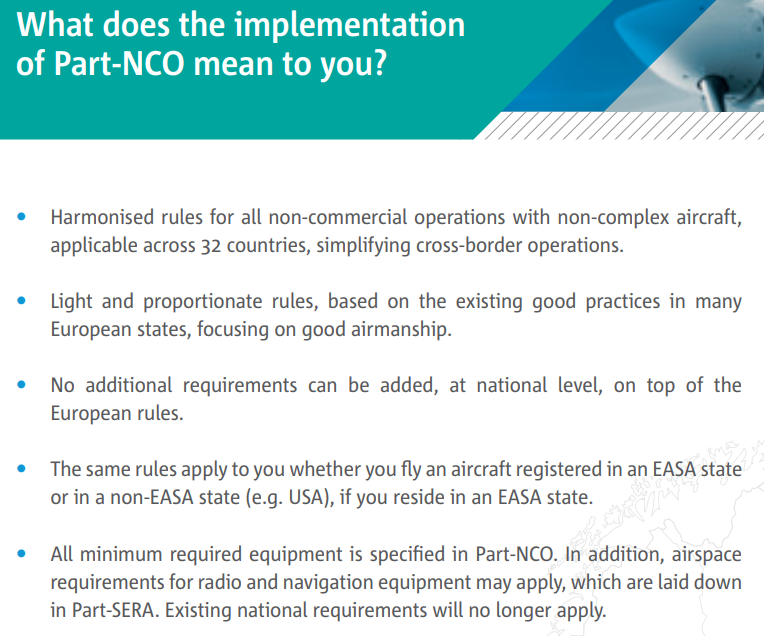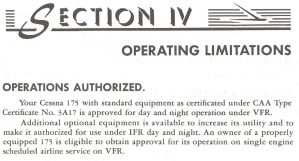Last updated: 09/27/2018
Introduction
Your Cessna, Piper or any other GA aircraft might be fit for IFR and you don’t even know it. Europe had many different national regulations that required autopilots, DMEs, ADFs, slaved gyros and specific approvals for PBN capabilities. Switzerland was no exception. That is now all gone, thanks to Part-NCO.
Sound decision making and common sense now step into the void of missing over-regulation. This blog post guides you the way, if you are unsure if your aircraft may be used under instrument flight rules. Please note that all of this, however, does not apply to Annex I aircraft (under the old Basic Regulation formerly known as Annex II).
EU No 800/2013, or simply Part-NCO, superseded national regulations (if they existed before) and this has been a big step towards simpler and better rules for General Aviation. It became effective on August 25th 2016 in Switzerland and all of Europe.
Absolutely no national regulations may be added to the EU laws. If you have doubts about that, have a look at this EASA GA Leaflet about “Flying in the EU – Ops is in the air”:

Many Swiss general aviation aircraft are now suddenly very close to being IFR capable. Any Cessna 172 probably only requires two more maintenance checks for basic en-route IFR flying. Depending on factory installed instrumentation it might even be fit for IFR approaches.
The European rules are now very similar in character to the FAA’s Part 91.
Before flying IFR
If you are going on an IFR flight, you should check the following points:
- Type certificate: Kinds of operation
Does the type certificate data sheet or POH list IFR as a possible kind of operation? - Basic instrumentation
Does the airplane fulfill NCO.IDE.A.125? - Communication and transponder equipment
Does the airplane fulfill NCO.IDE.A.190/200? - Navigation equipment
Does the airplane fulfill NCO.IDE.A.195? - Maintenance
Have the transponder and static system been tested within the last 24 months?
Remember, what’s legal isn’t necessarily safe. Plan your flight with the equipment limitations in mind. With the minimum IFR equipment you might have to restrict yourself to fair-weather IFR with just a few stratus clouds to climb through.
The easiest way to become familiar with the requirements are the Easy Access Rules to Air Operations, available from EASA (search the pdf for “NCO.”). Of course, the rest of Part-NCO applies to you as well, but these are the most important bits.
Let’s look at the above mentioned checklist in more detail. For IFR flying you need the following:
1. Type certificate: Kinds of operation
Check if the type certificate allows IFR. Look up your airplane’s Type Certificate Data Sheet, TCDS, on the EASA or FAA website). If your airplane is antique or classic, it might have been certified under CAR 3 and the kind of operation could not be listed. In that case read your POH, it should mention IFR capabilities in Section 4 “Operating limitations”.



2. Basic instrumentation
NCO.IDE.A.125 IFR minimum equipment
- Magnetic compass;
- Clock displaying h, min, s (wrist watch is sufficient);
- Altimeter;
- Airspeed indicator;
- Vertical speed indicator;
- Turn and slip indicator;
- Attitude indicator;
- Directional gyro or other stabilized heading indicator;
- Outside air temperature;
- Vacuum pressure gauge;
- Pitot heat.

Does your plane check all the IFR boxes?
3. Communication and transponder equipment
NCO.IDE.A.190 Radio communication equipment
- Two-way radio, only if required by airspace or RMZ.
In airspace classes A-E, two-way communications must be maintained at all times. In airspace classes F-G only when entering an RMZ. However, IFR aircraft must be equipped with a radio, even on a flight that does not require its use (e.g. complete flight in airspace class G without RMZ).
NCO.IDE.A.200 Transponder
- Transponder, only if required by airspace or TMZ.
4. Navigation equipment
NCO.IDE.A.195 Navigation Equipment
- Navigation equipment enabling to proceed according to the ATS flight plan and airspace requirements (except VFR by reference to landmarks, a.k.a. pilotage);
- Sufficient navigation equipment to have a backup (e.g. any combination of two independent navigation systems: two CDIs, CDI/ADF, CDI/IFR GPS, possibly even radar vectors plus only one navigation system, etc.);
- If landing in IMC, the equipment required for the approach.
PBN specification
GM1 and GM2 of NCO.IDE.A.195 explain, which PBN specification may be used. It basically says that you must find a statement in your official aircraft documentation that defines the PBN specification. In new aircraft you’ll find this information in the POH/AFM, in most other aircraft it will be stated in the AFM supplement (AFMS). This would be the case for after-market Avidyne IFD or Garmin GTN installations.

5. Maintenance
- Pitot-static system test;
- Transponder test.
These tests should have been complied with within the last 24 calendar months. In Switzerland, mechanics are asked to make a note in the journey log of the airplane that the tests have been passed to IFR standards.
However, if I look up Part-M I see a requirement for a test each year and for any airplane, be it IFR or VFR. On the other hand, on EuroGA.org, some people even suggest that today’s transponders check themselves and thus the requirement is fulfilled automatically. I don’t know the answer to that. I would simply stick to what my mechanic tells me. Update 09/27/2018: It is true that the yearly requirement of Part-M is an operational check only. However, an EASA SIB (SIB 2011-15R2) recommends an interval of 24 months. What you do with that recommendation is up to you.
Conclusion
The new Part-NCO rules give us a lot of freedom. It is our responsibility as pilot-in-command to check these five points set out above, before we take off under instrument flight rules. Depending on the airplane and its equipment, very much like your personal limits, you might be restricted to fair-weather IFR. We are asked to apply common sense by a regulation of EASA. Use the freedom, but don’t expect that what’s legal would be safe.
Note: This article has been updated in fall 2019 and was first published in mid 2016.



Hi Florian, I see a vacuum gauge as part of the IFR min equipment list, but what if the aircraft has no vacuum system? Does one just need a gauge stuck in a hole in the panel with nothing behind, with the indicator fixed in the green zone ??? 😉
Vince
LikeLiked by 1 person
Hi Vince
Good idea! Not sure if your mechanic would sign that off, though… 😉
I probably over-simplified what NCO.IDE.A.125 actually says. In proper EASA English the regulation says, quote: a means of indicating when the supply of power to the gyroscopic instruments is not adequate;
I suppose you always have some kind of indication, even with ram air suction. Never flew with anything other than electric gyros w/ INOP flag and vacuum gyros with vacuum gauge.
Thanks for your comment!
Florian
LikeLike
Hi,
what about those airplanes which have not vacuum gyros? I am thinking about Pipistrel Explorer 121A (EASA CS-LSA Type certified), for example, it uses the G3X Touch avionics with solid-state ADAHRS. Is this the reason why that model is not IFR certified?
Gianmarco
LikeLike
Hi Gianmarco! It doesn’t matter how the attitude indicator works, as long as it is an approved instrument for the airplane. If a vacuum system is replaced there is always an STC with a manual, the AFMS or airplane flight manual supplement, which states if IFR is permitted or under which conditions. Sometimes a backup AI is needed. We replaced our vacuum system with dual G5 and an electric backup AI. I think it’s much more reliable than a vacuum pump.
A quick look at the TCDS of the Pipistrel shows capability for VFR day and night (if certain equipment is added). So no IFR from the factory. In theory they, or someone else, could come up with an STC to extend to IFR. But the biggest hurdle might be the composite airframe, which is more vulnerable to lightning strikes. IFR is possible, as the Diamond aircraft show, but it is a big design consideration.
LikeLike